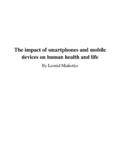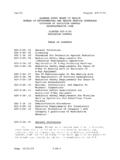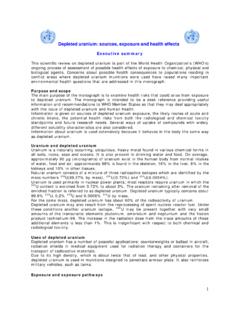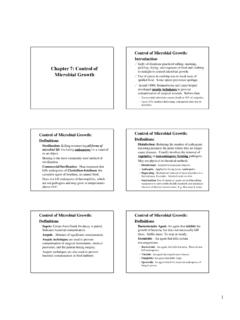Transcription of RADON AND HEALTH - WHO
1 INFORMATION SHEET FINAL. October 2002. RADON AND HEALTH . What is RADON and where does it come from? RADON is a natural radioactive gas without odour, colour or taste. It cannot be detected without special equipment. RADON occurs as a product of uranium decay. Uranium is a natural radioactive material found in varying amounts in all rocks, soil, concrete and bricks. It occurs everywhere on earth, especially in rocky and mountainous areas. RADON is an unstable radionuclide that disintegrates through short lived decay products before eventually reaching the end product of stable lead. The short lived decay products of RADON are responsible for most of the hazard by inhalation.
2 RADON and its decay products called RADON daughters or RADON progeny emit highly ionizing alpha-radiation. Decay products are suspended in the air which we breathe. Although the risk is very low when RADON is diluted to extremely low concentrations in the open, RADON in room air typically contributes up to 50% to the background radiation (fig 1.). However, in places such as caves and mines, it can accumulate up to dangerous concentrations and may cause substantial HEALTH damage after long-term exposure . RADON can also be found in drinking water and this can sometimes present a hazard. Certain types of geology, such as granite and volcanic soils, as well as aluminous shales, are more likely to contain RADON .
3 Conversely, low concentrations of this gas are expected in sedimentary rocks. Figure 1. Sources and average distribution of natural background radiation for the world population (UNSCEAR, 2000). 1. How RADON is measured Radioactivity of a radionuclide, for instance RADON , is reported in becquerels, Bq. 1 becquerel (1 Bq) = 1 disintegration of atom per second RADON concentrations in the air are measured as the amount of radioactivity (Bq) in a cubic metre of air (Bq/m3). The average RADON level outdoors is 5 Bq/m3 and in the homes of the United Kingdom, for instance, is 20 Bq/m3 of air. How does RADON enter houses? RADON gas enters houses from the ground through cracks in concrete floors and walls, through gaps between floor and slab, and around drains and pipes, and small pores of hollow-block walls ( ).
4 Consequently, RADON levels are usually higher in basements, cellars and ground floors. Depending on a number of factors, the concentration of RADON indoors varies with the time of the year, from day to day, and from hour to hour. Because of this time-variation, reliable measurements of mean concentrations in air should be made for at least three months. The level of RADON in homes can be measured with simple device that are returned to the testing company to interpret the results. HEALTH effects of RADON The adverse HEALTH effects of exposure to RADON are caused primarily by damage due to alpha-particles. The possible effects will depend on exposure level.
5 The main danger from high RADON exposure is an increased risk of lung cancer. RADON as a noble gas is rapidly exhaled after being breathed in; however, RADON progeny, combine with other molecules in the air and with particles of dust, aerosols or smoke, and readily deposit in the airways of the lung. While lodged there, the progeny emit ionizing radiation in the form of alpha particles, which can damage the cells lining the airways. Experiments have confirmed that ionizing radiation affecting bronchial epithelial cells could cause cancer. 2. Epidemiological studies on thousands of uranium miners in different countries, including Germany, USA, Canada, Czechoslovakia, and others, also support this fact.
6 Analyses have been undertaken of several miner studies, totalling 68,000 men of whom 2,700 died from lung cancer. An increased risk of all histological types of lung cancer, including small cell carcinoma, adenocarcinoma, and squamous cell carcinoma, has been associated with occupational exposure to RADON . But exposure to RADON in houses can also lead to lung cancer. It is believed, for example, that every year more than 15 000 deaths from lung cancer occur due to RADON exposure in the United Sates and more than 2 500 deaths in the United Kingdom. Lung cancer risk is much higher when RADON exposure is combined with smoking. According to the BEIR IV report of the US National Academies of Sciences, for men exposed to RADON at work, smokers were 10 times more likely to get lung cancer risk than non-smokers.
7 The risk of lung cancer from RADON in home can be estimated by two ways: by direct epidemiological studies of residential RADON and by projecting occupational risk estimates to lower levels of RADON in homes. The uncertainties associated with residential studies are larger than those with miner studies, primarily because the risk is smaller at the low exposures encountered in most homes. It is also difficult to estimate the RADON exposures that people have received over their lifetimes, probably in several houses. Despite the uncertainties , it is clear that far more lung cancers are caused by smoking than are caused by RADON . It is believed that the relationship between RADON and risk of lung cancer is linear.
8 In other words, doubling the exposure doubles the risk and halving the exposure halves the risk. Doubling of the risk means much more for a smoker, who is already at high risk of lung cancer, than for a non-smoker with a very small base line risk. Lung cancer risk from residential RADON exposure is substantially lower since the exposure in homes is much lower than in mines, although the risk increases with RADON concentration level and duration of exposure . For life-time exposure to RADON of 20 Bq/m3 level at home the risk of lung cancer is estimated to be (or 3 deaths in 1000 people). For comparison, risk of accidental death at home is (or 7 in 1000).
9 It has been suggested that other effects of RADON exposure include increased risk of non- malignant respiratory diseases but this is much less clearly established than the lung cancer risk. It is still not clear whether children are more sensitive to RADON exposure . Studies on childhood leukaemia (the most common form of cancer in childhood) have not found clear evidence of risk associated with RADON concentrations in homes. 3. RADON in drinking water Ninety-five percents (95%) of exposure to RADON is from indoor air; about one percent (1%) is from drinking water sources. Most of this 1% drinking water exposure is from inhalation of RADON gas released from running water activities, such as bathing, showering, and cleaning.
10 Only of exposure is from swallowing drinking water contaminated with RADON gas. Although the effects of ingested RADON are not fully understood, calculations suggest that the great majority of the radiation dose from such exposure is in the stomach. In many countries, some homes obtain drinking water from groundwater sources (springs, wells, adits, and boreholes). Because of its volatility, RADON contamination occurs primarily in ground, not surface, water sources of drinking water. Underground, this water often moves through rock containing natural uranium that releases RADON to the water. That is why, water from wells normally has much higher concentrations of RADON than surface water such as rivers, lakes, and streams.
















